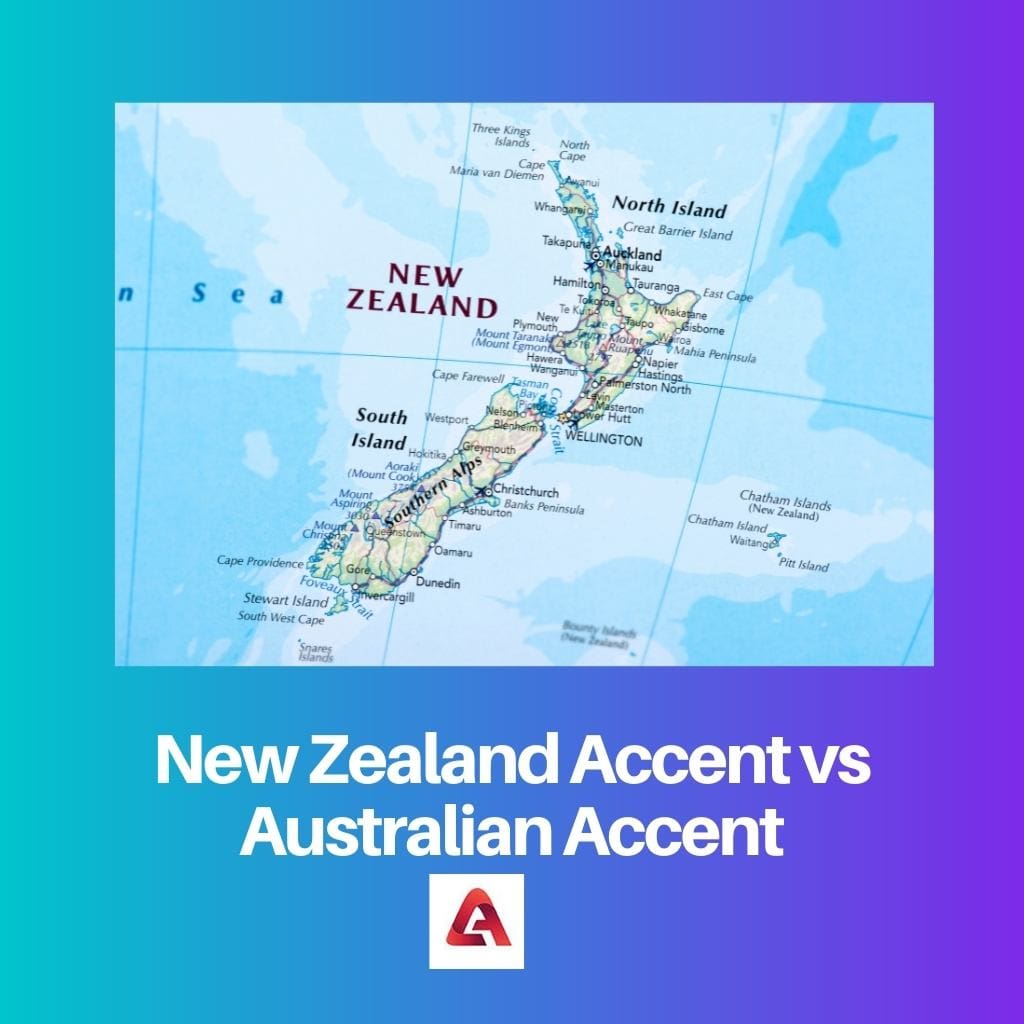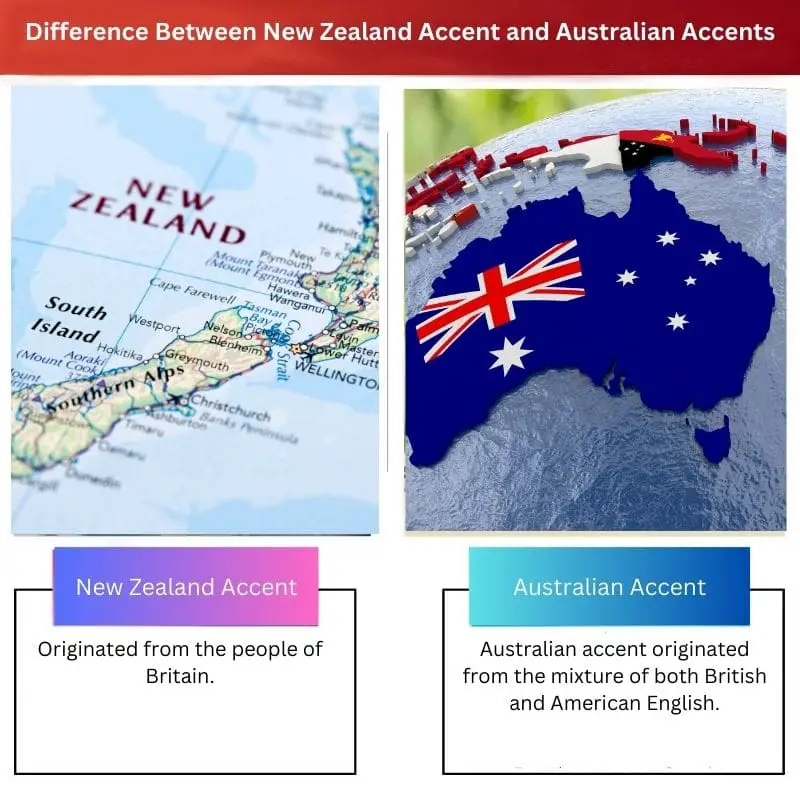The New Zealand accent is characterized by a melodious and vowel-centric quality, with a distinct pronunciation of words like “fish and chips.” In contrast, the Australian accent tends to be more flat and nasal, featuring a unique blend of British and indigenous influences.
Key Takeaways
- The New Zealand accent is characterized by a “flattened” vowel sound, while the Australian accent features a more pronounced “twang.”
- The New Zealand accent emphasizes the “i” vowel sound, while the Australian accent emphasizes the “o” sound.
- Overall, the New Zealand accent is considered more neutral and less distinct than the Australian accent.
New Zealand Accent vs Australian Accent
New Zealanders tend to have a more “sing-song” intonation and may drop the “r” sound in words, The New Zealand accent is characterized by a higher pitch. Australians tend to have a flatter, more nasal accent and lengthen vowel sounds.

It might seem like a small change in their way of speaking, but the Kiwis got a different type of accent on them that makes them identifiable. If you are curious to know how there is a difference between the two then look it up on YouTube and see how they speak.
Comparison Table
| Feature | New Zealand Accent | Australian Accent |
|---|---|---|
| Dominant Vowel Sound | More prominent “u” sound (e.g., “fish” pronounced as “fush”) | More prominent “ee” sound (e.g., “fish” pronounced as “feesh”) |
| Intonation | Generally flatter and less varied | More rising and falling intonation, described as “sing-songy” |
| “R” Sound | Often dropped or softened at the end of words | Pronounced more clearly, with a slight “h” sound after it (“rh”) |
| Vocabulary | Shares some unique slang terms with Australia but also has distinct New Zealand vocabulary (“chuffed” – happy, “bach” – small beach house) | Shares some unique slang with New Zealand but also has distinct Australian vocabulary (“mate” – friend, “fair dinkum” – honest) |
| Speed | Generally spoken slightly slower than Australian English | Generally spoken slightly faster than New Zealand English |
| Closeness to British English | Considered slightly closer to British English, especially in vocabulary | Considered somewhat distinct from both British and American English |
What is New Zealand Accent?
The New Zealand accent, referred to as “Kiwi accent,” is a distinctive and unique way of pronouncing English that is specific to the people of New Zealand. This accent has evolved over time and is influenced by various linguistic factors, including historical developments, geographical isolation, and cultural influences.
Characteristics of the New Zealand Accent
- Vowel Shifts: The New Zealand accent is characterized by vowel shifts, where certain vowel sounds differ from those in other English accents. For example, the short “i” sound in words like “kit” may be pronounced as a centralized and raised vowel, creating a distinct sound.
- Shortening of Vowels: Another notable feature is the shortening of certain vowels. This can be observed in words like “bed” or “pen,” where the vowel sound may be pronounced more quickly and with less emphasis compared to other English accents.
- Rhoticity: New Zealand English is non-rhotic, meaning that the “r” at the end of words and before consonants is not pronounced. However, there can be variations in rhoticity based on regional differences within New Zealand.
- Intonation Patterns: The intonation patterns in the New Zealand accent may differ from other English accents. There is a unique melody or rhythm to the way sentences are spoken, influenced by regional variations and cultural factors.
- Consonant Pronunciation: While many consonant sounds remain similar to other English accents, there may be subtle differences in the pronunciation of certain consonants, especially when they appear at the beginning or end of words.
- Maori Influence: The Maori language, spoken by the indigenous people of New Zealand, has had an impact on the New Zealand accent. Some Maori sounds and speech patterns have influenced the way certain words are pronounced in English.
- Regional Variations: It’s important to note that the New Zealand accent is not uniform across the entire country. There are regional variations, and people from different parts of New Zealand may exhibit distinct features in their speech.

What is Australian Accent?
The Australian accent is a distinctive and unique way of speaking English that is associated with the people of Australia. It is characterized by its vowel sounds, intonation patterns, and pronunciation of certain consonants. The Australian accent has evolved over time, influenced by various factors such as historical settlement, regional variations, and cultural influences.
Phonological Features
- Vowel Sounds: One of the most notable features of the Australian accent is the pronunciation of certain vowel sounds. For instance, the vowel in words like “dance” and “chance” is pronounced with a more open mouth, creating a distinct sound.
- Rhoticity: Australian English is non-rhotic, meaning that the “r” at the end of a syllable or before a consonant is not pronounced. This is a characteristic feature shared with other British-influenced accents.
- Diphthongs: The Australian accent features unique diphthongs, where two vowel sounds are combined within the same syllable. For example, the diphthong in the word “ride” might be pronounced differently compared to other English accents.
Intonation Patterns
- High Rising Terminal (HRT): Australians are known for their distinctive rising intonation at the end of statements, which can make declarative sentences sound like questions. This is commonly referred to as the “High Rising Terminal.”
- Lack of T-Intonation: In some instances, Australians may exhibit a lack of T-intonation, particularly in words ending with “-ing.” This can result in a more flattened or softened pronunciation of the final “t” sound.
Regional Variations
- Broad vs. General Accent: Within Australia, there are regional variations in the accent. The Broad Australian accent, associated with rural areas, can have more pronounced features. In contrast, the General Australian accent, associated with urban areas, is considered more neutral.
- Influence of Indigenous Languages: The Australian accent has also been influenced by Indigenous languages, particularly in terms of pronunciation and vocabulary in certain regions.
Cultural Influences
- Multiculturalism: Australia’s multicultural society has contributed to the diversity of accents, with individuals from various linguistic backgrounds bringing their unique speech patterns to the country.
- Media and Globalization: Exposure to global media, including television, movies, and the internet, has led to some leveling of accents, as Australians are increasingly exposed to a variety of English accents from around the world.

Main Differences Between New Zealand Accent and Australian Accent
New Zealand Accent:
- Vowel Pronunciation:
- Shortening of vowels is common, e.g., “bed” may sound like “bid.”
- The “i” sound is pronounced as a short “uh” sound.
- Consonant Pronunciation:
- The “r” sound is not pronounced at the end of words or before consonants, similar to British English.
- The “d” sound in words like “bed” can be pronounced more like a soft “d,” almost like “bede.”
- Intonation:
- Generally flatter intonation compared to the Australian accent.
- Rising intonation at the end of statements is less common.
- Distinctive Words:
- Certain words may have unique pronunciations, such as “fish and chips” sounding more like “fush and chups.”
- Lack of Nasality:
- Generally less nasal compared to the Australian accent.
Australian Accent:
- Vowel Pronunciation:
- Vowels are elongated, e.g., “day” may sound more like “die.”
- The “i” sound is pronounced with a long “ah” sound.
- Consonant Pronunciation:
- The “r” sound is commonly pronounced at the end of words and before consonants.
- The “d” sound in words like “bed” is pronounced more like a standard “d.”
- Intonation:
- More varied intonation, with rising intonation at the end of statements being common.
- Intonation tends to be more melodious compared to the flatter New Zealand accent.
- Distinctive Words:
- Certain words may have unique pronunciations, such as “dance” sounding more like “dahnce.”
- Nasality:
- Some Australians may exhibit a slight nasal quality in their speech.





